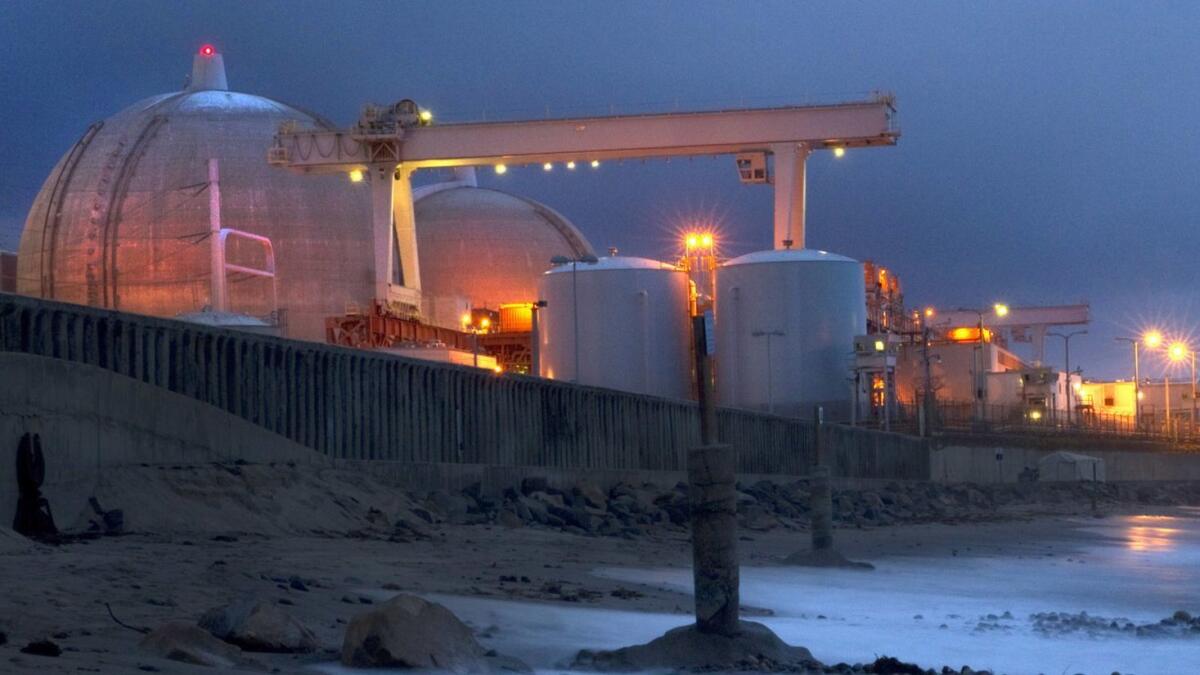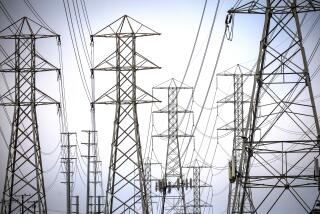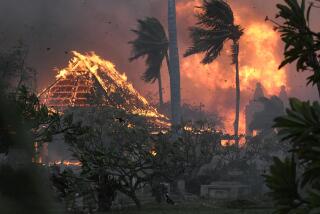Column: San Onofre and the wildfires: Why utilities need to be held strictly to their responsibilities

While everyoneâs attention is focused on the wildfires spreading devastation across California, a couple of developments tangentially related have gone largely unnoticed.
Weâre talking about roughly $1 billion in settlements reached by California utility companies with regulators, much of which is to be credited to ratepayers as compensation for the companiesâ malpractice, error or venality. The settlements break down as more than $775 million â and possibly up to $900 million â that will be charged to Southern California Edison shareholders, not customers, related to its shutdown of its San Onofre nuclear plant in 2012, and $119.5 million to be paid by Southern California Gas Co. for its Aliso Canyon methane leak.
The utilitiesâ involvement is what ties those settlements to the wildfires. The stateâs electric utilities already are on the hook for billions of dollars in costs connected to wildfires in recent years; more is certain to be assessed, for utility operations rank high among the leading causes of fires.
To give utilities a blank check on the ratepayersâ backs gives them a disincentive to operate properly.
— Maria Severson, San Diego attorney
But the stateâs major utilities â Edison, San Diego Gas & Electric Co., and Pacific Gas & Electric Co. â are working the Legislature hard to place limits on their liability for the fires. And they appear to have won the ear of Gov. Jerry Brown, who has proposed a change in the rule that would relieve utilities of liability as long as they were found to have acted âreasonablyâ to mitigate the chance of fire. But critics argue that could shift the cost of wildfires to insurers, who would pass them on to their own customers in the form of higher premiums.
These cases all are iterations of an ancient battle over whether ratepayers or shareholders should pay when a publicly owned utility encounters unexpected costs. Traditionally, the answer has turned on âprudenceâ: If a utility operates prudently, even if its activities result in a costly error, then the ratepayers may have to shoulder that cost. If the companies took unreasonable risks, skimped on safety measures or committed avoidable errors, the shareholders should get the bill.
But thereâs more to the issue as it applies to wildfires. Under Californiaâs strict liability doctrine, which is applied to fire damage related to utility facilities, owners of damaged property can collect from the utility even without showing that a fire resulted from negligence.
The utilities argue that strict liability no longer makes sense for wildfires, since climate change has driven the frequency, severity and costs of these events higher, out of all proportion to reasonable expectations of utility liability. PG&E has even warned that its billions of dollars of exposure to fire costs could drive it into bankruptcy.
Consumer advocates warn, however, that lessening the companiesâ liability would invite less prudent behavior.
âTo give utilities a blank check on the ratepayersâ backs gives them a disincentive to operate properly,â says Maria Severson, a San Diego lawyer who participated in the San Onofre negotiations. âTheir only incentive would be to operate for the highest profit.â
The San Onofre case illustrates how hard a utility sometimes will fight to avoid sticking its shareholders with a big bill. The apportioning of costs stemming from Edisonâs decision in June 2013 to permanently mothball the nuclear plant received final approval from the California Public Utilities Commission only on July 26. The time span between those two dates was fraught with all the twists of a political thriller, including an alleged attempt by Edison at a secret deal with regulators and multiple threats of lawsuits.
The case began with a botched attempt by Edison, the plantâs principal owner, to upgrade its steam generators. The new equipment began to show unusual wear and tear within two years of its installation, decades too early, forcing the plant to be taken off line in the first months of 2012. It would never be restarted.
The battle soon began over how to divide up the cost of building and running San Onofre prior to the generator fiasco between customers and shareholders. A negotiated settlement between Edison and consumer advocates in April 2014 called for ratepayers to cover about 56% of the costs, or about $3.1 billion, with Edison and its junior partner in the plan, San Diego Gas & Electric, splitting 27%. The remaining 17% would be covered by insurers and from other recoveries.
In February 2015, however, it was discovered that Edison executives had secret contacts with PUC President Michael Peevey and other commission representatives regarding settlement terms â including a face-to-face meeting between Peevey and then-Edison Executive Vice President Stephen Pickett at an industry conference in Warsaw two years earlier. The consumer groups bailed out of the deal and the PUC fined Edison $16.7 million for failing to report the meetings.
The second round of settlement talks resulted in a better deal for ratepayers, whose share of the costs was reduced to 40%. In effect, at least $775 million was shifted to the shareholdersâ accounts. Edison is portraying the result as an unalloyed boon for consumers, though it hasnât said much lately about its years of efforts to bill them more. The settlement will result in a one-time bill credit averaging $11 per residential customer, reflecting customer charges Edison collected in excess of the final settlement, and a permanent bill reduction averaging 2%, or $2 a month. SDG&E residential customers will get a one-time credit averaging about $6.84, and a permanent reduction of about 0.9%, or $1.33 per month.
Consumer advocates say the key to the revised settlement was the transparency of the process. âThe game-changer was that we had a history of scandalous behavior by the utilities and Peevey that was on the record,â Matthew Freedman, a staff attorney at the consumer group TURN who participated in the talks, told me. âThere was a much bigger level of public scrutiny on the outcome. That gave the ratepayer groups a lot more leverage to negotiate a superior deal.â
That brings us back to the wildfires. Brown is concerned that âwe could lose our utilitiesâ if their fire-related financial burden intensifies, as he said during a news conference on Aug. 1. âAnd if we do that, our whole program, of trying to deal with renewable energy and mitigate climate change, would be adversely affected.â
So heâs looking for a way to reduce the utilitiesâ liability without encouraging them to slacken their efforts to reduce fire risk â for example, by requiring them to file and comply with âfire mitigation plansâ that include trimming vegetation around power lines.
Utility critics argue that no pre-filed plan can possibly impose the same incentive for fire safety as the threat of a financial drubbing.
In two reports on the 2017 fire season released earlier this summer, the California Department of Forestry and Fire Protection, or Cal Fire, associated PG&E equipment with the causes of most of the 16 fires it investigated. Cal Fire referred 11 of the fires to district attorneys in Napa, Sonoma, Lake, and Humboldt counties to review allegations that PG&E had violated state law, generally by allowing vegetation to come in contact with live wires. Twelve people died in the 16 fires. Investigations of other fires are continuing.
And last November, a PUC administrative law decision rejected San Diego Gas & Electricâs bid to pass $379 million in expenses from three 2007 wildfires on to its ratepayers, on the grounds that the utility failed to operate prudently in the fire zone and did not âreasonably manage and operate its facilitiesâ prior to the blazes. This allowed sparks and other faults to start the fires.
As state Sen. Hannah-Beth Jackson (D-Santa Barbara) asked at a Sacramento hearing Thursday on Brownâs proposal, âWhy should we reduce utilitiesâ liability and expect them to do moreâ to mitigate fire risk?
Sheâs right. There arenât many ways to keep profit-making utilities sensitive to their responsibilities, but strict liability is one of them. The Legislature should be very cautious about loosening the chains.
Keep up to date with Michael Hiltzik. Follow @hiltzikm on Twitter, see his Facebook page, or email [email protected].
Return to Michael Hiltzikâs blog.
More to Read
Get the L.A. Times Politics newsletter
Deeply reported insights into legislation, politics and policy from Sacramento, Washington and beyond. In your inbox three times per week.
You may occasionally receive promotional content from the Los Angeles Times.











